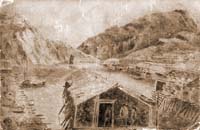A Cautious Beginning:
The Court of Civil Jurisdiction 1791
by Christopher English and Christopher
Curran
Ignoring Statute:
The 18th Century Indigenous Regime
Although these arrangements could be rationalized as temporary expedients,
they seemed to recognize and respond to the fact of settlement. The population
was growing, from 3,000 in 1728 to double that by mid-century, and to 16,000
by 1764. How was it, then, that even after 1800 when the population surpassed
20,000 the governors could canvass the prospects for mass resettlement and
deportation?21
Two hypotheses suggest themselves. They lead one to
inquire into the nature of the population which was increasing and the sort of
economic growth which sustained it.
St. John's Harbour
Untitled. A view of the entrance of St. John's from inland. Anonymous and undated,
it is likely from the late 18th century. The left foreground shows a multitude of
fish flakes on upright poles.
Courtesy of The Rooms Provincial Museum Division, St. John's, NL.
 (37 kb).
(37 kb). |
 |
To this point we know little about these 18th century immigrants to
Newfoundland. The climate and prospects for employment in sectors outside
the fishery were no more favourable than in the past. So long as the fishery
remained a migratory one, as it did past mid-century, the incidence of
immigration by merchants or professionals was likely to be modest. One might
suggest that a significant proportion of the small population was made up of
young single men who stayed on in Newfoundland at the end of the fishing
season. In all likelihood their home communities in the West Country or in
southern Ireland, where the ships stopped each season to fill their complement
of seamen and fishermen, offered little incentive to return. (The Irish by 1750
were said to outnumber the English in St. John's.) Some may have preferred
the risks and possibilities for adventure and a better future in a new land to the
bleak prospects and rural and urban poverty of life at home. Evidently a blind
eye was turned toward the 1699 prohibition against carrying passengers to
Newfoundland. The ships regularly carried a complement of dieters - men who
signed on for a single voyage in return for room and board. With their return
passage money, or a portion of it, in hand, they might eke out an existence in
St. John's looking for work, or bartering a promise to work in the local fishery
the following summer in exchange for lodging over the winter months. Dieter is
an imprecise term and appears to have been generally applied to male
seasonal workers who were neither householders nor perceived as stable, or
potentially respectable, members of the community. The first week in May
when the ships arrived from England and the cod fishery was getting underway
was marked by the cry: "Out dogs, and in dieters!" In all likelihood many of
these young men were transients, spending a season or two in Newfoundland.
Noted for their drunkenness and violence, they were the despair of the
"respectable" classes and considerable relief accompanied their moving on to
greener pastures on the
mainland.22

|
Quidi Vidi Harbour, 1801
A view of Quidi Vidi Harbour drawn by Henry Trapnel in 1801.
Courtesy of The Rooms Provincial Museum Division, St. John's, NL.
 with more information (52 kb). with more information (52 kb). |
In the late 18th century the merchants appear to have been no more committed
to permanent residence than were the dieters. From St. John's in 1785, 47
West Country firms, together with two from London and one from Greenock,
supplied the fishery, usually on consignment, in exchange for first claim on the
catch. Only 12, a quarter of them, had been in Newfoundland before 1750, and
11 would be insolvent by the
1790's.23
Within such firms, it appears that
young men, frequently nephews of the principal owners back in Poole or
Dartmouth, would come out as agents or junior partners for a few years in
hopes of expanding business and making their fortunes. With the caution that
the data comes from the 1790's and the early 19th century, it appears that even
when one married a local girl it was quite typical to return to England in one's
early 40's to run the business from that end, or even to retire in a less rigorous
climate and a more civilized culture. Accordingly, many more people may have
passed through Newfoundland than gross population figures, themselves
unreliable, indicate. If such transients were drawn from all classes the pressure
which it was necessary for them to mount in favour of more permanent forms of
governance may have been lacking. The imperial response, ad hoc and
arguably temporary adjustments via governor's decree, may simply have
reflected the impermanence and modest growth of the settled population.
|



